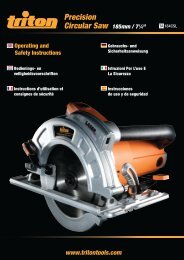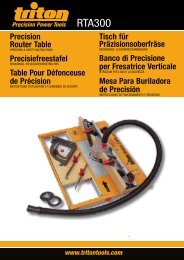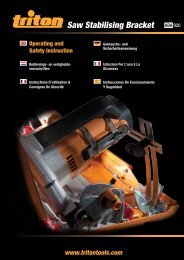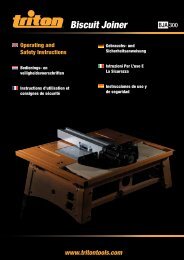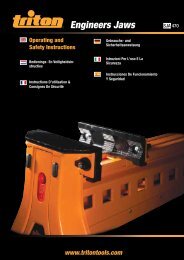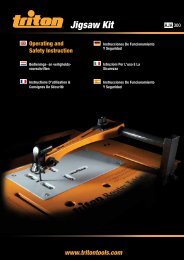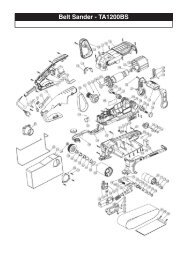Manual de instrucciones - Triton Tools
Manual de instrucciones - Triton Tools
Manual de instrucciones - Triton Tools
Create successful ePaper yourself
Turn your PDF publications into a flip-book with our unique Google optimized e-Paper software.
POWER TOOL USE AND CARE<br />
• Use clamps or other practical way to secure<br />
and support the work to a stable platform.<br />
Holding the work by hand or against your body<br />
is unstable and may lead to loss of control.<br />
• Do not force the tool. Use the correct tool for<br />
your application. The correct tool will do the<br />
job better and safer at the rate for which it is<br />
<strong>de</strong>signed.<br />
• Do not use the tool if switch does not turn<br />
it on or off. Any tool that cannot be controlled<br />
with the switch is dangerous and must be<br />
repaired. If there appears to be a problem refer<br />
to the “Trouble-shooting” and if necessary<br />
contact a repair centre.<br />
• Disconnect the plug from power before<br />
making any adjustments, changing<br />
accessories, or storing the tool. Such<br />
preventative measures reduce the risk of<br />
acci<strong>de</strong>ntal starting.<br />
• Store tool in a dry location, out of reach of<br />
children and untrained persons. This tool is<br />
dangerous in the hands of untrained users.<br />
• Maintain tools with care. Keep cutting tools<br />
sharp and clean. Properly maintained tools,<br />
with sharp cutting edges are less likely to bind<br />
and are easier to control.<br />
• Check for misalignment (ie. excessive<br />
vibration), binding of moving parts, or any<br />
damage that may affect the tools operation.<br />
If damaged have the tool serviced before using.<br />
Many acci<strong>de</strong>nts are caused by<br />
poorly maintained tools.<br />
• Never start the tool while the bla<strong>de</strong> is<br />
touching the workpiece.<br />
• Avoid acci<strong>de</strong>ntal starting. Ensure the switch<br />
is in the off-position before plugging in.<br />
Carrying power tools with your finger on the<br />
switch or plugging in power tools that have the<br />
switch on invites acci<strong>de</strong>nts.<br />
• Remove adjusting keys or wrenches before<br />
turning the tool on. A wrench or a key that is<br />
left attached to a rotating part of the tool may<br />
result in injury.<br />
• Accessories and metal parts can become<br />
very hot.<br />
ADDITIONAL SAFETY<br />
WARNINGS FOR LASER LIGHTS<br />
The laser light/laser radiation used in this<br />
product is Class 2 with maximum 1mW<br />
and 650nm wavelengths. These lasers do<br />
not normally present an optical hazard,<br />
although staring at the beam may cause<br />
flash blindness.<br />
Do not stare directly at the laser beam.<br />
A hazard may exist if you <strong>de</strong>liberately stare<br />
into the beam. Please observe all safety rules as<br />
follows:<br />
• The laser shall be used and maintained in<br />
accordance with<br />
the manufacturer’s instructions.<br />
• Never aim the beam at any<br />
person or an object other than<br />
the work piece.<br />
• The laser beam shall not be <strong>de</strong>liberately<br />
aimed at personnel and shall be prevented<br />
from being directed towards the eye of a<br />
person for longer than 0.25s.<br />
• Always ensure the laser beam is aimed<br />
at a sturdy work piece without reflective<br />
surfaces, ie.<br />
wood or rough coated surfaces<br />
are acceptable. Bright shiny reflective<br />
sheet steel or the like is not suitable for laser<br />
use as the reflective surface could direct the<br />
beam back at the operator.<br />
• Do not change the laser light assembly with<br />
a different type. Repairs must only be carried<br />
out by the laser manufacturer or an authorised<br />
agent.<br />
Use of controls or adjustments or performance<br />
of procedures other than those specified<br />
herein may result in hazardous radiation<br />
exposure.<br />
Please refer to the relevant European standard<br />
EN60825-1 : 1994 + A2: 2001 + A1 : 2002 for<br />
General Safety Rules 5<br />
GB



